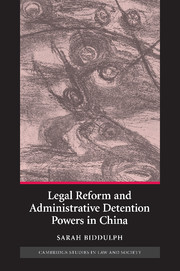Book contents
- Frontmatter
- Contents
- Preface
- Abbreviations
- Part 1 Introduction and conceptual framework
- Part 2 Social order and administrative detention
- Part 3 Legal reform and its impact on administrative detention
- 7 Building a legal environment for police detention
- 8 Supervision of police conduct: legalisation and contest
- 9 Legal reform catches up with administrative detention
- Part 4 Analysis and conclusion
- Appendix 1 Index of Legislation, administrative regulations, rules, normative documents, Party documents, speeches and cases
- Bibliography
- Index
7 - Building a legal environment for police detention
Published online by Cambridge University Press: 27 July 2009
- Frontmatter
- Contents
- Preface
- Abbreviations
- Part 1 Introduction and conceptual framework
- Part 2 Social order and administrative detention
- Part 3 Legal reform and its impact on administrative detention
- 7 Building a legal environment for police detention
- 8 Supervision of police conduct: legalisation and contest
- 9 Legal reform catches up with administrative detention
- Part 4 Analysis and conclusion
- Appendix 1 Index of Legislation, administrative regulations, rules, normative documents, Party documents, speeches and cases
- Bibliography
- Index
Summary
INTRODUCTION
In chapters 4, 5 and 6, my examination of the development of administrative detention powers in the context of social order policy since the late 1970s has shown the perseverance of political and administrative definitions of both the scope and procedures for imposing administrative detention. Although the purposes for the imposition of administrative detention are now more pragmatic than ideological, administrative detention remains a flexible tool for use by the public security organs.
The focus of the inquiry changes in chapters 7, 8 and 9 to consider administrative detention from the point of view of the legal system. I examine developments in the legal regulation of administrative powers of state organs and how they impact on administrative detention.
In this chapter, I first discuss Party leadership of the public security organs, both organisational and ideological, and of enforcement policy. I contend that legalisation of police power occurs within the parameters of Party leadership and that the authority of the Party in advocating ‘governance according to law’ has given impetus to efforts to legalise and regularise police power.
I then focus on two interrelated issues. First, the process of legalisation and rationalisation of state power since 1978 and how this has impacted on police administrative detention powers. I consider the extent to which the developments in the legal system under the policy of ‘administration according to law’ (yifa xingzheng 依法行政) have created pressure for administrative detention powers to be structured legally rather than politically and administratively.
- Type
- Chapter
- Information
- Legal Reform and Administrative Detention Powers in China , pp. 223 - 274Publisher: Cambridge University PressPrint publication year: 2007



